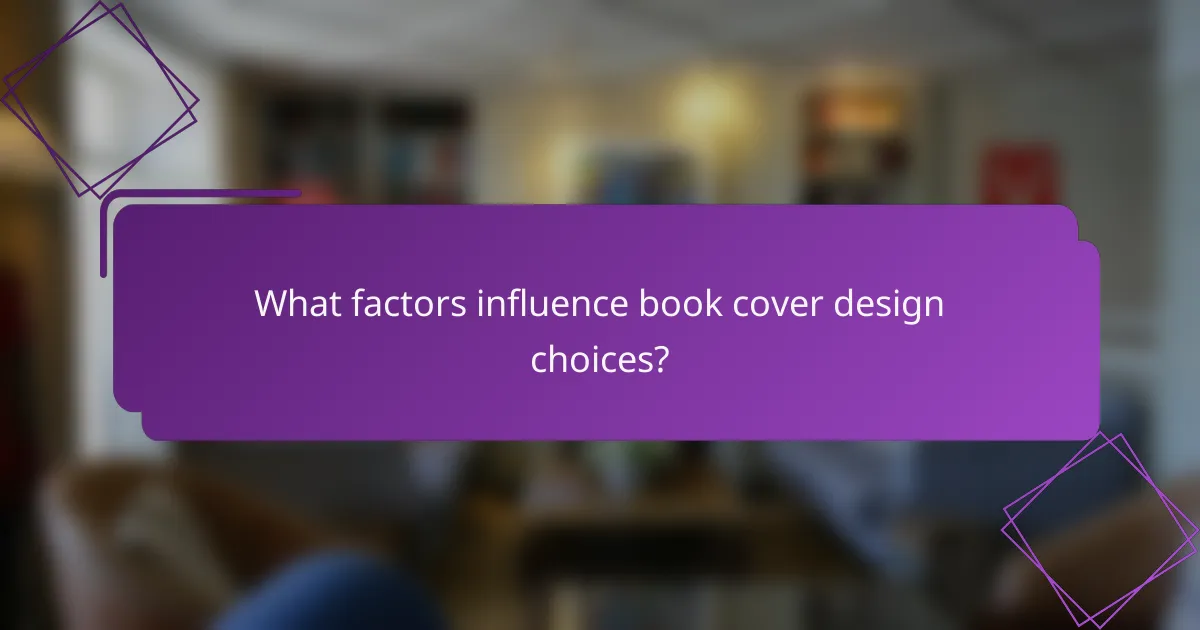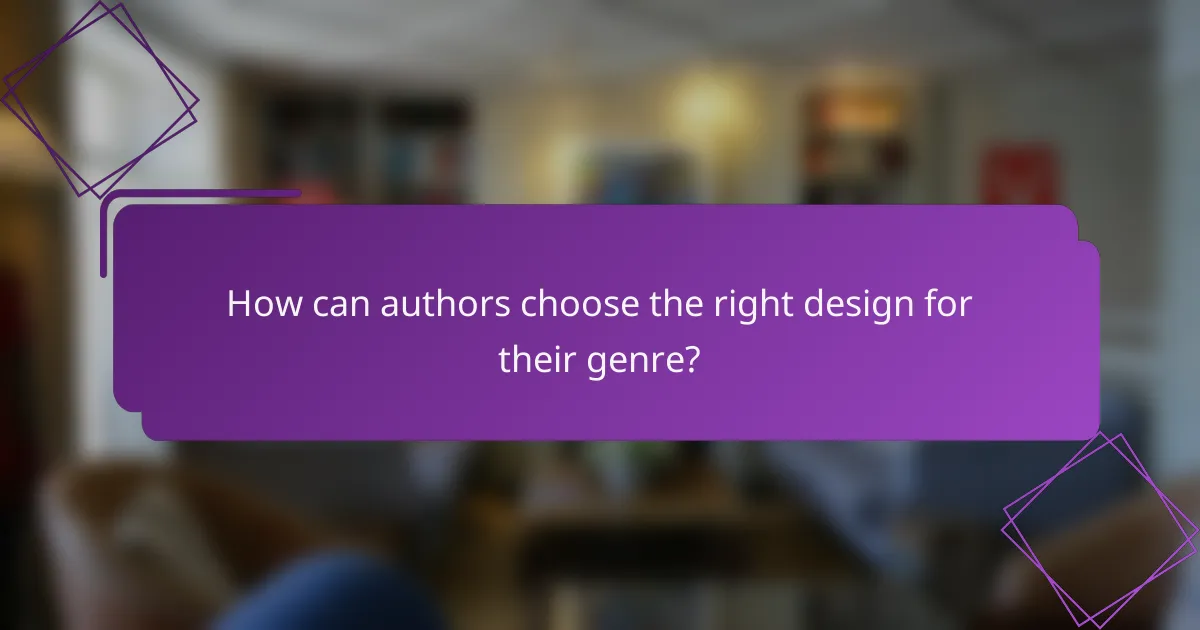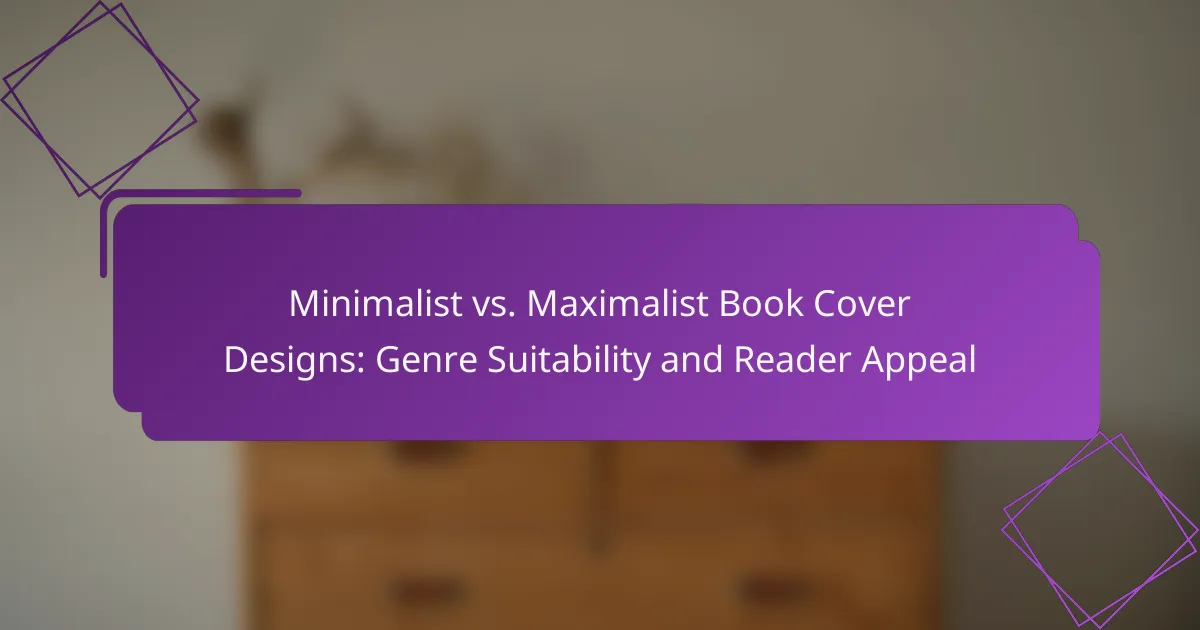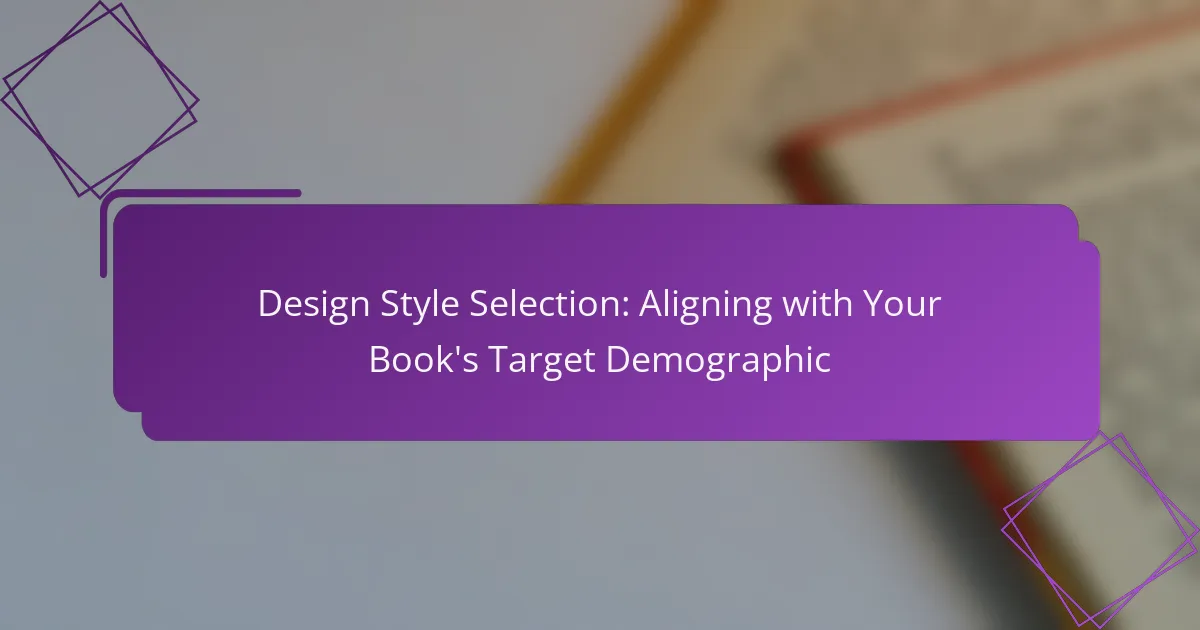The debate between minimalist and maximalist book cover designs highlights the importance of visual appeal in attracting readers. Minimalist covers, with their clean aesthetics, resonate with modern audiences, while maximalist designs, rich in detail, cater to genre enthusiasts. Understanding the genre and target audience is crucial in selecting the appropriate style to enhance a book’s marketability.

Which book cover design is more appealing to readers?
Minimalist book cover designs tend to attract modern readers due to their clean aesthetics, while maximalist designs appeal to genre enthusiasts who appreciate intricate details. The choice between these styles often hinges on the target audience and the genre of the book.
Minimalist designs attract modern readers
Minimalist designs focus on simplicity, using limited colors and imagery to convey the essence of the book. This approach resonates with contemporary readers who often prefer a sleek, uncluttered look that stands out on digital platforms and physical shelves alike.
For example, a minimalist cover might feature a single striking image or a bold title against a plain background. This style is particularly effective in genres like literary fiction, self-help, and contemporary romance, where the emphasis is on the narrative rather than elaborate visuals.
Maximalist designs appeal to genre enthusiasts
Maximalist designs embrace complexity, often incorporating vivid colors, intricate illustrations, and elaborate typography. This style attracts readers of genres such as fantasy, science fiction, and historical fiction, where detailed artwork can reflect the richness of the story’s world.
For instance, a maximalist cover might showcase a fantastical landscape filled with characters and symbols relevant to the plot. This approach not only captures attention but also invites readers to explore the depth and imagination of the narrative, making it a popular choice among genre aficionados.

How do minimalist book covers enhance genre suitability?
Minimalist book covers enhance genre suitability by emphasizing simplicity and clarity, which often resonates with specific literary styles. These designs can effectively communicate the essence of contemporary fiction and literary genres, attracting the right audience through visual cues.
Clean lines signify contemporary fiction
Clean lines and sparse design elements are hallmarks of contemporary fiction book covers. This style often appeals to readers looking for modern narratives that reflect current themes and societal issues. For example, a cover featuring a single, bold typeface on a solid background can convey a sense of sophistication and relevance.
When designing a minimalist cover for contemporary fiction, consider using a limited color palette and focusing on typography. This approach can create an inviting and fresh look that draws in potential readers. Avoid cluttered imagery that may distract from the central message of the book.
Subtlety suggests literary genres
Subtle design elements in minimalist covers often indicate literary genres, appealing to readers who appreciate depth and nuance. A cover that uses understated graphics or muted colors can suggest a thoughtful narrative, inviting readers to explore complex themes. For instance, a simple illustration of a landscape can evoke a sense of place without overwhelming the viewer.
To effectively convey literary themes through minimalist design, focus on symbolism and metaphor. Choose imagery that reflects the book’s core message while maintaining an air of mystery. This strategy can entice readers who enjoy unraveling deeper meanings within the text, making them more likely to pick up the book.

What are the advantages of maximalist book covers?
Maximalist book covers offer several advantages, particularly in their ability to captivate potential readers. These designs often feature intricate artwork and bold colors, making them stand out on crowded bookshelves or online marketplaces.
Vibrant visuals attract attention
Maximalist covers utilize vibrant visuals that can immediately draw a reader’s eye. Bright colors, detailed illustrations, and dynamic typography create a striking first impression. This visual impact can be crucial in genres like fantasy or adventure, where the artwork can convey the excitement and complexity of the story.
To maximize attention, consider using contrasting colors and unique design elements that reflect the book’s themes. For example, a fantasy novel might feature a richly illustrated landscape, while a thriller could use dark, moody imagery to evoke suspense.
Complexity reflects genre depth
The complexity of maximalist designs often mirrors the depth of the genre they represent. Genres such as historical fiction, science fiction, or epic fantasy benefit from detailed covers that hint at intricate plots and rich world-building. This complexity can signal to readers that the book offers a layered and immersive experience.
When designing a maximalist cover, ensure that the elements used—such as character depictions or symbolic imagery—are relevant to the story. This alignment helps set reader expectations and enhances the overall appeal of the book.

How do book cover designs affect sales?
Book cover designs significantly influence sales by attracting potential readers and conveying genre expectations. A well-designed cover can create an emotional connection, prompting impulse purchases or fostering brand loyalty.
Minimalist covers drive impulse purchases
Minimalist book covers often feature simple designs with limited text and imagery, making them visually striking and easy to process. This simplicity can lead to quick decisions, especially in crowded retail environments where readers may only glance at a cover for a few seconds.
For genres like contemporary fiction or self-help, minimalist designs can effectively communicate clarity and focus. They appeal to readers looking for straightforward narratives or practical advice, often resulting in higher impulse buys.
Maximalist covers create lasting impressions
Maximalist covers, characterized by intricate designs and vibrant colors, tend to leave a strong visual impact. These covers can attract attention and spark curiosity, making them memorable long after the initial encounter.
Genres such as fantasy or historical fiction benefit from maximalist designs, as they can encapsulate complex worlds and themes. However, while they may not drive immediate purchases as effectively as minimalist covers, they can foster a deeper connection with readers who appreciate detailed artistry and storytelling.

What factors influence book cover design choices?
Book cover design choices are influenced by various factors, including the target audience, market trends, and genre conventions. Understanding these elements helps authors and publishers create appealing covers that resonate with readers and effectively convey the book’s themes.
Target audience preferences
Target audience preferences play a crucial role in book cover design. Different demographics may respond better to minimalist or maximalist designs based on their tastes and expectations. For example, younger readers may lean towards bold, vibrant covers, while older audiences might prefer more subdued, classic aesthetics.
To effectively cater to your audience, consider conducting surveys or analyzing successful books within your genre. This can provide insights into color schemes, typography, and imagery that resonate with your specific readership.
Market trends in publishing
Market trends significantly impact book cover design choices. Currently, many genres are seeing a shift towards minimalist designs, which emphasize simplicity and clarity. This trend is particularly evident in genres like literary fiction and self-help, where clean lines and ample white space are favored.
Conversely, genres such as fantasy and romance often embrace maximalist designs, featuring intricate illustrations and vibrant colors. Staying updated on these trends through industry reports or design blogs can help ensure your cover aligns with current market expectations and stands out on shelves.

How can authors choose the right design for their genre?
Authors can choose the right book cover design by aligning their choices with genre conventions and understanding their target audience. Minimalist designs may appeal to certain genres, while maximalist covers can attract readers in others.
Analyze genre conventions
Each genre has established visual norms that readers expect. For example, romance novels often feature soft colors and romantic imagery, while thrillers might use dark tones and bold typography. Familiarizing yourself with these conventions can guide your design choices.
Consider creating a mood board that includes popular covers from your genre. This can help you identify common elements and themes, allowing you to either conform to or creatively deviate from these standards to stand out.
Consider reader demographics
Understanding your target audience is crucial for effective cover design. Different age groups and cultural backgrounds may respond differently to minimalist versus maximalist designs. For instance, younger readers might prefer vibrant, intricate covers, while older audiences may favor simpler, more classic styles.
Conduct surveys or focus groups to gather feedback on cover prototypes. This direct input can provide insights into what resonates with your demographic, ensuring your design appeals to potential readers and enhances marketability.

What are the emerging trends in book cover designs?
Emerging trends in book cover designs reflect a blend of creativity and technology, focusing on both minimalist and maximalist approaches. These trends emphasize visual storytelling, reader engagement, and the integration of modern digital elements.
Integration of digital elements
The integration of digital elements in book cover designs is becoming increasingly popular, as it allows for dynamic visuals that can engage readers more effectively. This can include augmented reality features, animated graphics, or interactive components that enhance the reading experience.
For example, some publishers are using QR codes that link to author interviews or book trailers, creating a multi-dimensional experience. This trend is particularly appealing to younger audiences who are accustomed to digital interactions.
Personalization in cover art
Personalization in cover art is another emerging trend, allowing readers to feel a deeper connection to the book. This can involve custom designs based on reader preferences or even the option to choose from multiple cover variants for the same title.
Publishers are increasingly offering limited edition covers or allowing readers to submit their own designs for contests. This approach not only boosts engagement but also caters to niche markets, making the book more appealing to specific demographics.

How do cultural influences shape book cover aesthetics?
Cultural influences significantly shape book cover aesthetics by dictating design preferences, symbolism, and color schemes that resonate with specific audiences. Understanding these influences can help authors and publishers create covers that appeal to their target demographic.
Regional design preferences
Different regions exhibit distinct design preferences that reflect their cultural values and artistic traditions. For example, minimalist designs are often favored in Scandinavian countries, where simplicity and functionality are paramount, while maximalist styles may be more popular in regions that celebrate vibrant colors and intricate patterns, such as parts of South America.
When designing a book cover, consider the cultural context of your target audience. Research local trends and popular aesthetics to ensure that your cover resonates with readers. For instance, a cover featuring bold typography and rich imagery might attract attention in markets that appreciate maximalism, while a clean, understated design could appeal more to readers in minimalist-oriented cultures.
Symbolism and color significance
Colors and symbols carry different meanings across cultures, which can greatly impact the effectiveness of a book cover. In many Western cultures, blue often symbolizes trust and calmness, making it a popular choice for genres like self-help and business. Conversely, in some Eastern cultures, red signifies good fortune and happiness, which could be more suitable for romance or children’s books.
When selecting colors and symbols for your book cover, consider their cultural implications. Research the meanings associated with different colors in your target market to avoid misinterpretations. For example, using a color that is considered unlucky in a specific culture could deter potential readers.
Trends and market expectations
Book cover trends can vary significantly by region, influenced by local publishing practices and reader expectations. In the United States, for instance, bold and eye-catching designs are often used to stand out in a crowded market, while European covers may lean towards more artistic and conceptual approaches.
To align with market expectations, analyze bestsellers in your genre and region. Pay attention to common design elements, such as typography, layout, and imagery. This can guide your design process and help ensure your cover meets the standards that readers in that market anticipate.


